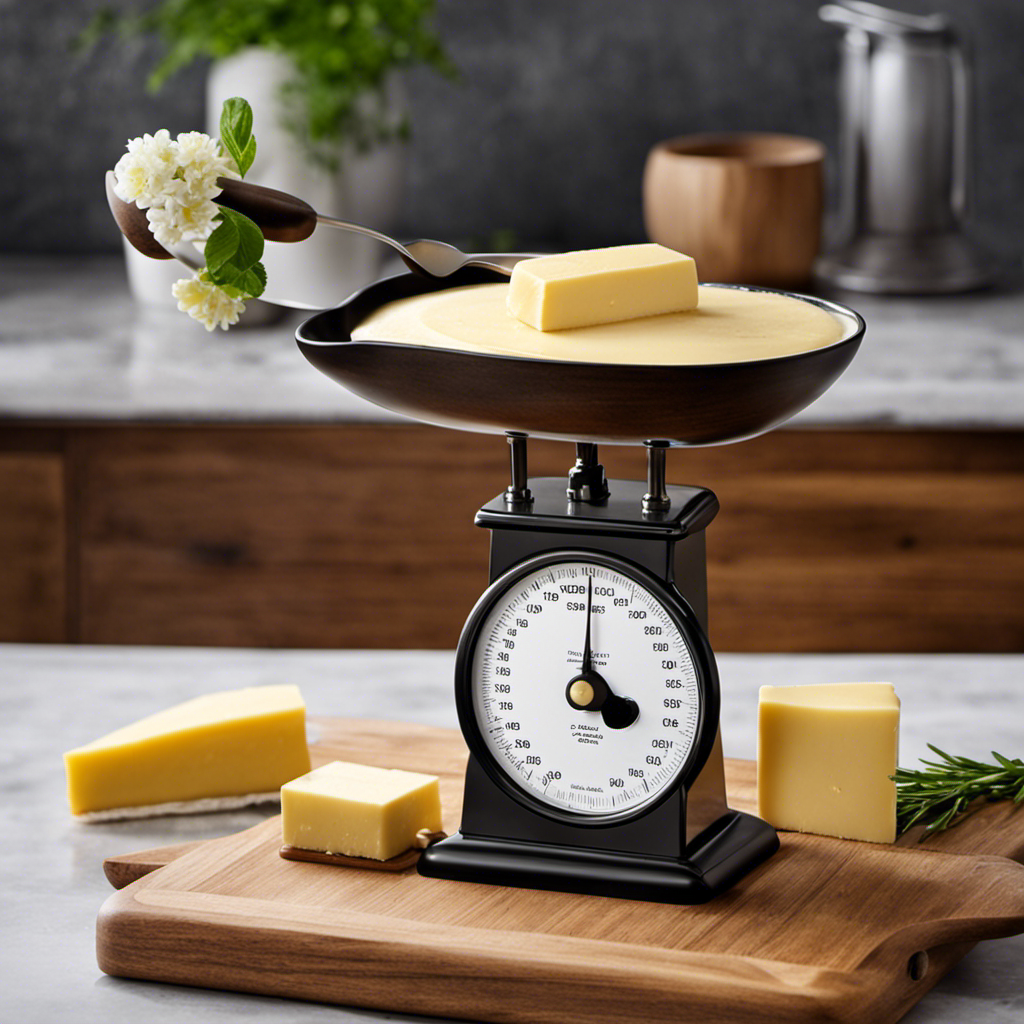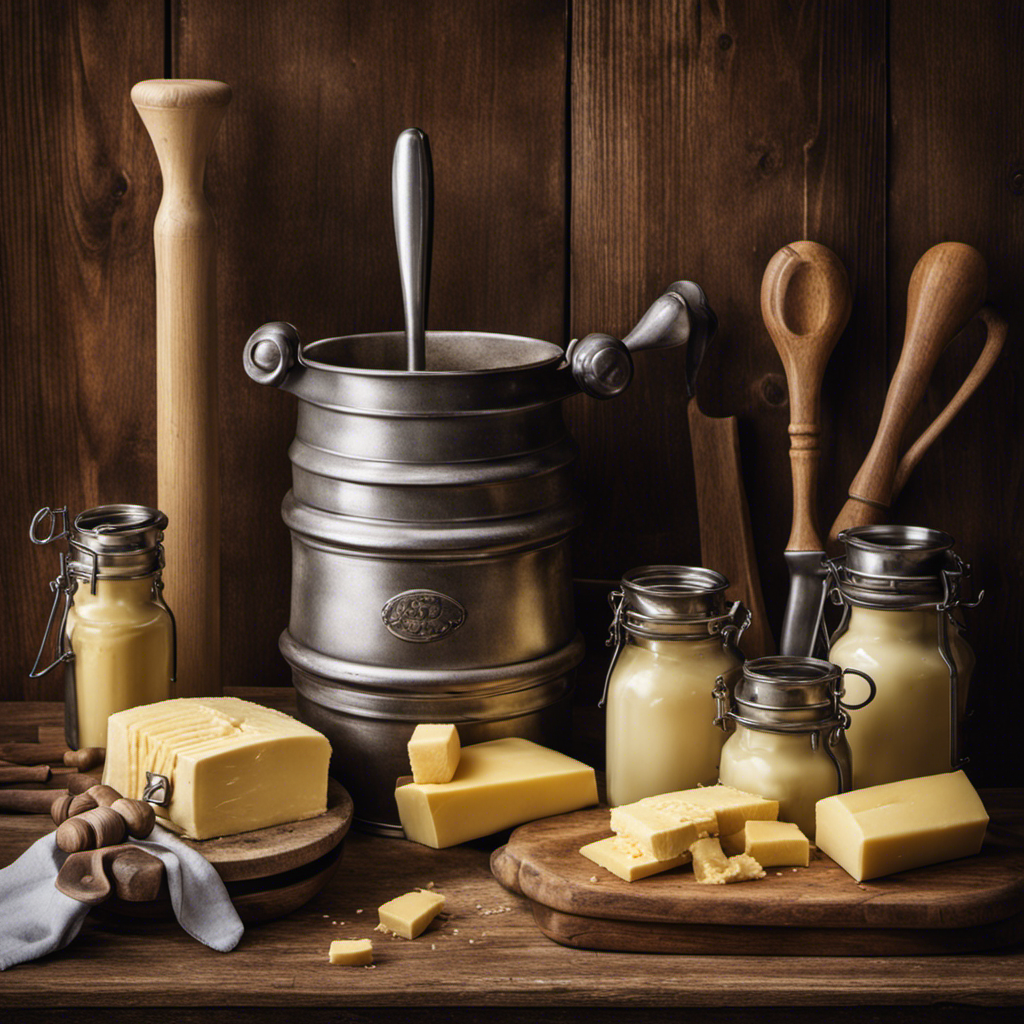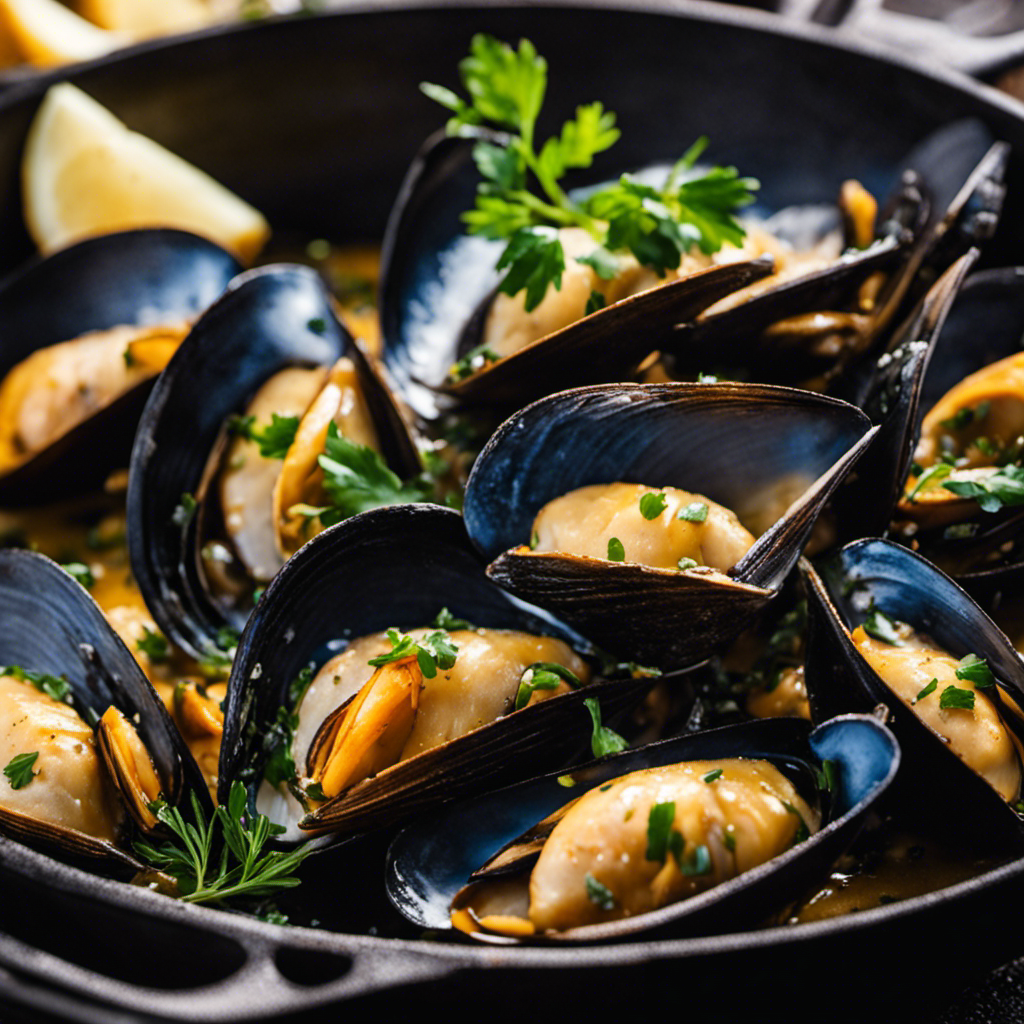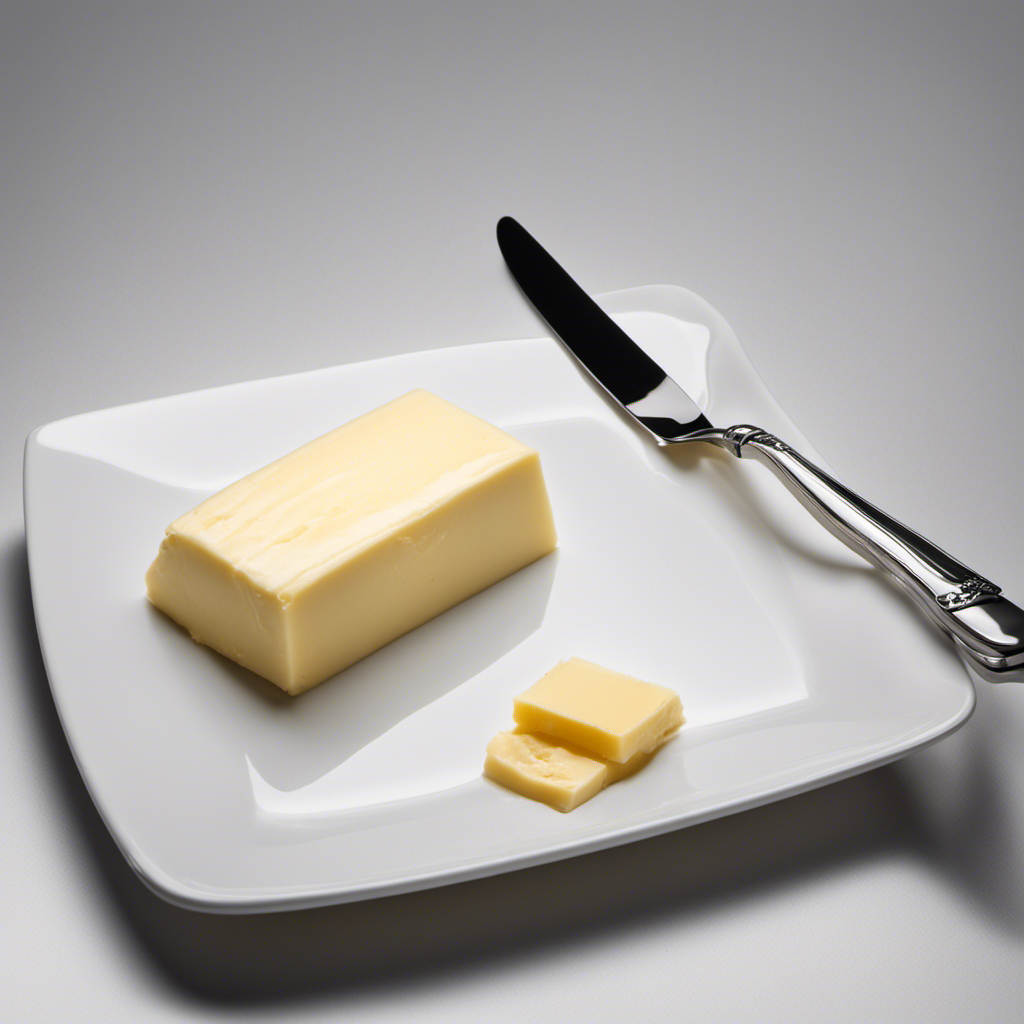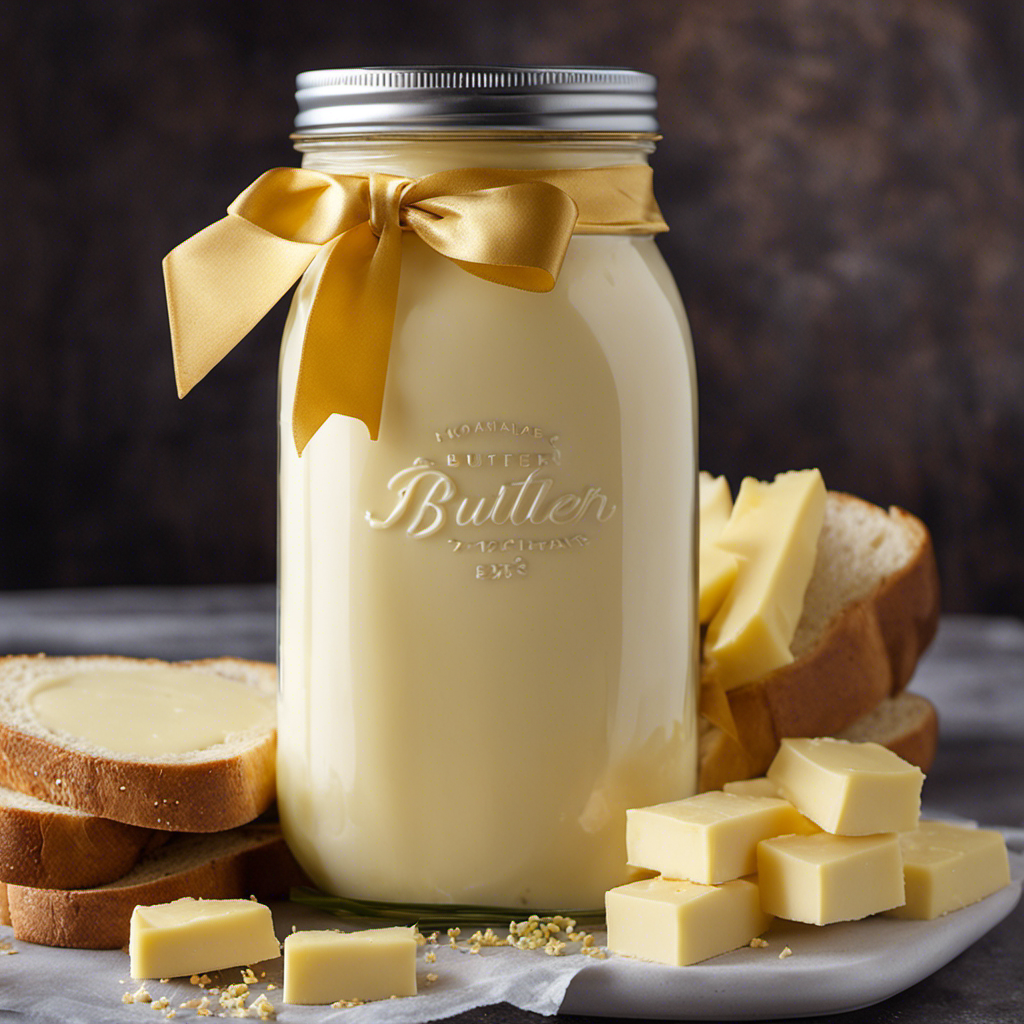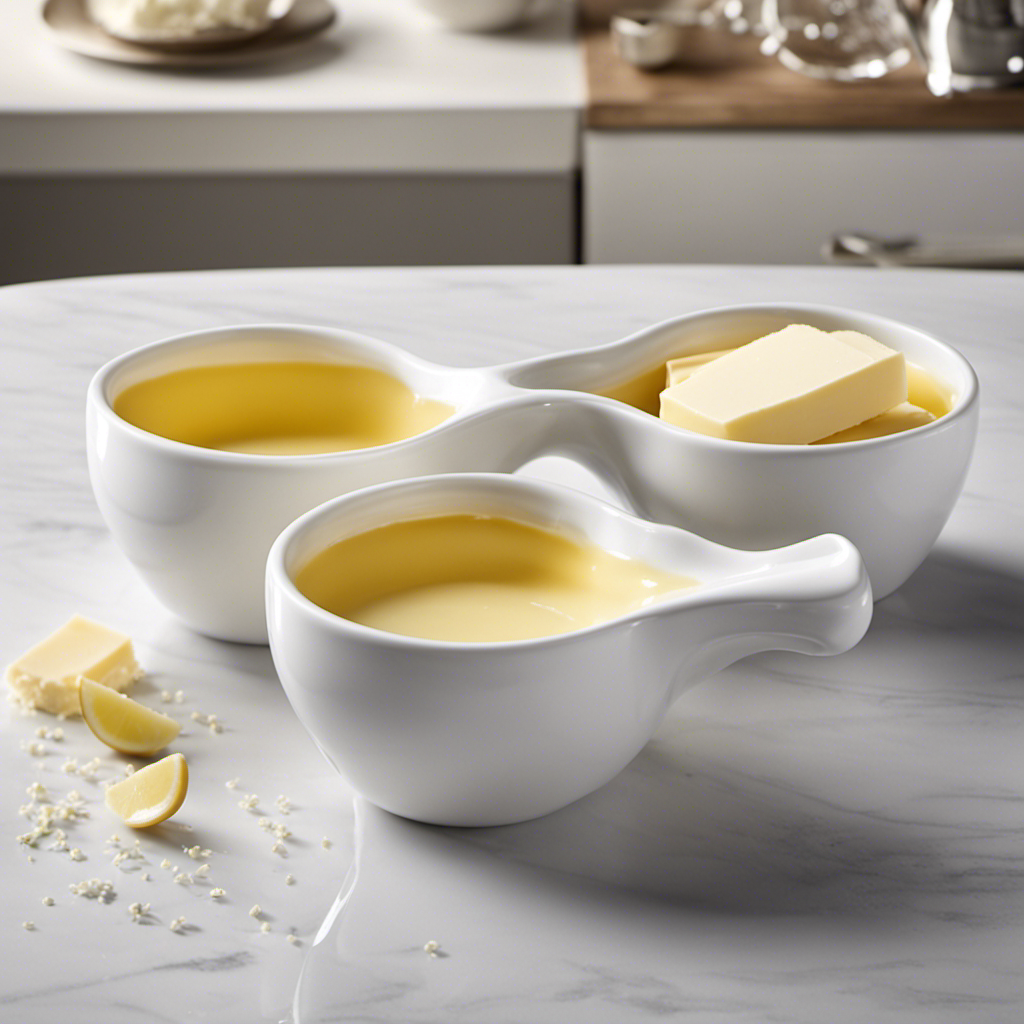As someone who is passionate about cooking and loves exploring culinary delights, I frequently catch myself pondering the exact measurements of ingredients. A common question that tends to come up is the number of grams found in a tablespoon of butter.
In this article, we will delve into the world of tablespoon measurements, explore the conversion from tablespoons to grams, and uncover the standard measurement for butter.
Join me as we navigate the intricacies of measuring butter accurately and effectively in both grams and tablespoons.
Key Takeaways
- A tablespoon is larger than a teaspoon and there are three teaspoons in one tablespoon.
- Different countries may have different standards for measuring butter, so it’s important to double-check the specific conversion chart being used for accuracy.
- The weight of butter can vary depending on its density and temperature, but in the United States, 1 tablespoon of butter is approximately 14.2 grams.
- Grams provide a more precise and consistent measurement compared to tablespoons, so using grams ensures accurate measurements in baking.
Understanding Tablespoon Measurements
A tbsp of butter is equivalent to about 14 grams.
When it comes to measuring ingredients, it is important to understand the common units used in recipes. One common unit for measuring butter is the tablespoon (tbsp). A tablespoon is a volume measurement, and it is often used interchangeably with teaspoon (tsp) in recipes. However, it is important to note that a tablespoon is larger than a teaspoon. In fact, there are three teaspoons in one tablespoon.
So, if a recipe calls for 2 tablespoons of butter, it would be equivalent to 6 teaspoons. Understanding these common butter measurements is essential for accurate recipe preparation.
Now, let’s dive into converting tablespoons to grams to further understand the weight measurement of butter.
Converting Tablespoons to Grams
To convert tablespoons to grams, you’ll need to use a conversion chart. When it comes to butter measurement conversions, it’s important to be precise. The weight of butter can vary depending on its density and temperature. Using a conversion chart specifically designed for butter will give you accurate results.
It’s crucial to note that different countries may have different standards for measuring butter. In the United States, 1 tablespoon of butter is equal to approximately 14.2 grams. However, it’s always advisable to double-check the specific conversion chart you’re using to ensure accuracy.
Understanding the weight of butter in a tablespoon is essential for precise cooking and baking.
The Weight of Butter in a Tablespoon
When it comes to converting tablespoons to grams, accuracy and precision are crucial. The weight of butter can vary depending on the type, such as salted, unsalted, or clarified butter.
Therefore, it is important to consider these different butter types when making conversions to ensure accurate measurements.
Conversion Accuracy and Precision
You’ll want to ensure the accuracy and precision of your conversions when determining how many grams are in a tbsp of butter. Understanding tablespoon accuracy and precision in conversion is crucial for accurate measurements in cooking and baking.
To achieve this, consider the following:
-
Use a reliable conversion chart: Consult a trusted source or reputable cooking guide that provides accurate conversions for various ingredients, including butter. This will help you avoid errors and ensure precise measurements.
-
Use a digital scale: When converting from tablespoons to grams, using a digital scale is highly recommended. A scale provides precise measurements, allowing you to achieve accurate results in your recipes.
-
Be consistent with measurement techniques: To maintain accuracy, use the same measurement technique consistently. For example, level off the tablespoon when measuring butter to ensure consistency in your conversions.
Different Butter Types
Different types of butter have varying textures and flavors, making them suitable for different culinary applications. Butter is a versatile ingredient that adds richness and flavor to both sweet and savory dishes.
One of the most common types of butter is unsalted butter, which is made from cow’s milk and contains no added salt. It has a smooth and creamy texture, making it perfect for baking and cooking.
Salted butter, on the other hand, has salt added during the churning process, giving it a slightly savory taste. It is commonly used for spreading on bread or toast.
Another type of butter is clarified butter, also known as ghee, which is butter that has been melted and simmered to remove the water and milk solids. This results in a rich, nutty flavor and a higher smoke point, making it ideal for sautéing and frying.
Overall, the different types of butter offer a range of flavors and textures, allowing chefs and home cooks to experiment and create delicious dishes.
The benefits of using butter in cooking include enhancing the taste and texture of dishes, adding depth and richness to baked goods, and providing a source of fat-soluble vitamins like vitamin A, D, and E.
Standard Tablespoon Measurement for Butter
In discussing the accuracy of tablespoon measurement and conversion factors for butter, it is important to consider the precision and reliability of these measurements in culinary applications.
As a researcher, I have found that the accuracy of tablespoon measurement can vary depending on factors such as the density and temperature of the butter being measured.
Additionally, conversion factors for butter, particularly between volume and weight measurements, must be taken into account to ensure accurate and consistent results in recipes.
Accuracy of Tablespoon Measurement
There’s a debate about the accuracy of measuring tablespoons. As a home cook, I understand the importance of accurate measurements in recipes. Here are three key points to consider when it comes to understanding tablespoon equivalents and the accuracy of measurements:
-
Variation in tablespoon size: Different countries have different tablespoon sizes, with the US tablespoon being slightly larger than the UK tablespoon. This can lead to discrepancies in measurements when following recipes from different sources.
-
Level vs. heaped tablespoons: The way a tablespoon is filled can also affect the accuracy of the measurement. For precise results, it is recommended to use a level tablespoon, which means removing any excess ingredients from the top.
-
Personal interpretation: Even when using the same tablespoon, individuals may interpret the measurement differently. This can result in inconsistent measurements and affect the outcome of a recipe.
Considering these factors, it is crucial to strive for accuracy when measuring tablespoons to ensure consistent and reliable results in cooking and baking.
Now, let’s delve into the conversion factors for butter.
Conversion Factors for Butter
In my research on the accuracy of tablespoon measurements, I discovered that converting butter measurements can be quite tricky. Different regions and countries have varying standards for butter measurements, making it necessary to understand the butter measurement equivalents.
One tablespoon of butter typically weighs around 14 grams or 0.5 ounces. However, it is important to note that this measurement may vary depending on the brand or type of butter. For instance, European butter is often sold in 250-gram blocks, and each tablespoon weighs around 15 grams.
To accurately convert butter measurements, it is helpful to know the different measurements used. In the United States, butter is commonly sold in sticks, with each stick weighing about 113 grams or 4 ounces. In the UK, butter is sold in 250-gram blocks, while in Australia, it is sold in 250-gram or 500-gram blocks.
Understanding these different butter measurements and equivalents is essential for precise cooking and baking.
Calculating Grams in a Tablespoon of Butter
To calculate the number of grams in a tablespoon of butter, you can use a conversion chart. Here are three key points to help you understand tablespoon equivalents and common uses for tablespoon measurements:
-
Standard Tablespoon Size: A standard tablespoon is equal to 14.79 milliliters (ml) or 0.5 fluid ounces (fl oz). This is the measurement most commonly used in recipes.
-
Butter Density: Butter has a density of approximately 0.911 grams per milliliter (g/ml). This means that for every milliliter of butter, you have 0.911 grams.
-
Calculating Grams: To calculate the grams in a tablespoon of butter, multiply the volume (in milliliters) by the density (in grams per milliliter). For example, if you have 14.79 ml of butter, the calculation would be: 14.79 ml x 0.911 g/ml = 13.47 grams.
Understanding tablespoon equivalents and common uses for tablespoon measurements is essential for accurate cooking and baking. Now, let’s move on to the next section about converting tablespoons to grams.
Conversions: Tablespoons to Grams
Converting tablespoons to grams is a helpful skill to have in the kitchen. Understanding the metric system and being able to convert measurements accurately can greatly enhance your cooking experience.
The benefits of using grams for measurements are numerous. Unlike tablespoons, grams provide a more precise and consistent measurement. This is especially important when it comes to baking, where accuracy is crucial for the success of your recipes.
Grams also allow for easier scaling of recipes, as you can easily multiply or divide the measurements without any loss of accuracy. By using grams, you can ensure that your dishes turn out just the way you want them to, every time.
Now, let’s delve into the specifics of measuring butter in the kitchen: grams vs tablespoons.
Measuring Butter in the Kitchen: Grams Vs Tablespoons
In my research, I have come to understand that measuring butter in the kitchen can be a bit tricky. The consistency of butter can vary depending on factors such as temperature and brand. This can affect the accuracy of measurements when using tablespoons or grams.
To navigate this, I have identified three key points to consider:
-
Stick to the recipe: When a recipe calls for butter in tablespoons, it is best to stick to that measurement. Recipes are often tested and developed with specific measurements in mind, so using grams instead may alter the final outcome.
-
Use a kitchen scale: If you prefer using grams or need to convert a recipe that only provides measurements in tablespoons, a kitchen scale can be a helpful tool. Weighing the butter will ensure accuracy and consistency in your baking or cooking.
-
Adjust for different consistencies: If you find that your butter is too hard or too soft, you can adjust the measurement accordingly. For example, if your butter is too soft, you can reduce the amount slightly. Conversely, if it is too hard, you can slightly increase the measurement.
Understanding the consistency of butter and being mindful of how to measure it in recipes can help ensure consistent and successful culinary endeavors.
How to Accurately Measure Butter in Grams
Accurately measuring butter in grams can be achieved by using a kitchen scale. One of the most common mistakes is using tablespoons or other volume measurements instead of grams. This can lead to inconsistencies in recipes and result in incorrect proportions of ingredients. By using a kitchen scale, you can ensure that you are accurately measuring the weight of your butter in grams. This is especially important in baking, where precise measurements can make a significant difference in the final outcome of your baked goods.
Tips for Precise Butter Measurements in Tablespoons
When it comes to measuring butter, it’s important to use tablespoons instead of volume measurements to ensure precise measurements. This is because butter is a solid and can vary in density, which can lead to inaccurate measurements when using cups or fluid ounces.
To achieve precision in measuring butter, consider the following tips:
-
Use a tablespoon: A tablespoon is a standardized unit of measurement and provides consistent results when measuring butter.
-
Pack the butter: To ensure accurate measurements, firmly pack the butter into the tablespoon, removing any air pockets or gaps.
-
Level off the top: Once the butter is packed into the tablespoon, use a straight edge, like a knife or spatula, to level off the top, creating an even and precise measurement.
Frequently Asked Questions
Can I Use a Different Type of Fat Instead of Butter in Recipes That Call for Tablespoons of Butter?
Yes, you can use a different type of fat instead of butter in recipes that call for tablespoons of butter. To measure other types of fats in tablespoons, consult a conversion chart or use a kitchen scale.
What Is the Difference Between a Standard Tablespoon Measurement and a Metric Tablespoon Measurement?
The difference between a customary tablespoon and a metric tablespoon lies in their measurement standards. Converting between tablespoons and grams without a scale requires accurate conversion factors based on density and volume.
How Can I Measure Butter in Grams if I Don’t Have a Kitchen Scale?
To measure butter without a scale, you can use the water displacement method. Fill a measuring cup with water, then add butter until the water level rises to the desired amount. Alternatively, you can use alternative fats in recipes that have similar properties to butter.
Are There Any Tips or Tricks for Measuring Butter in Tablespoons More Accurately?
To measure butter in tablespoons accurately, I suggest using a butter dish with tablespoon markings or a tablespoon scoop. Another tip is to soften the butter to make it easier to measure.
Is There a Specific Conversion Factor for Converting Tablespoons of Butter to Grams?
Oh, the elusive conversion factor for tablespoons of butter to grams! Many have searched for it, but alas, it doesn’t exist. Fear not, for I shall delve into alternative methods of measuring butter in grams without a kitchen scale.
Conclusion
In conclusion, after conducting thorough research, it is clear that measuring butter accurately is essential in various culinary endeavors. By understanding tablespoon measurements and converting them to grams, we can ensure precise and consistent results in our recipes.
While the weight of butter in a tablespoon may vary slightly, it is generally accepted that there are approximately 14 grams of butter in one tablespoon. So, whether you prefer measuring in grams or tablespoons, it’s crucial to have the right knowledge and tools to achieve culinary perfection.
As the saying goes, ‘Measure twice, cut once.’ ‘Measure twice, cut once, and savor the delicious results.’
